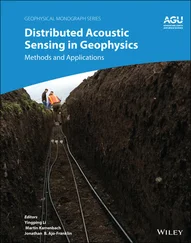10.4.2. DTS Implementation
The DTS service consists (conceptually) of several components. The time clerkis a daemon process that runs on client machines and keeps the local clock synchronized with the remote clocks. The clerk also keeps track of the linearly growing uncertainty of the local clock. For example, a clock with a relative error of one part in a million might gain or lose as much as 3.6 msec per hour, as discussed above. When the time clerk calculates that the possible error has passed the bound of what is allowed, it resynchronizes.
A time clerk resynchronizes by contacting all the time serverson its LAN. These are daemons whose job it is to keep the time consistent and accurate within known bounds. For example, in Fig. 10-17 a time clerk has asked for and received the time from four time servers. Each one provides an interval in which it believes that UTC falls. The clerk computes its new value of time as follows. First, values that do not overlap with any over values (such as source 4) are discarded as being untrustworthy. Then the largest intersection falling within the remaining intervals is computed. The clerk then sets its value of UTC to the midpoint of this interval.
After resynchronizing, a clerk has a new UTC that is usually either ahead or behind its current one. It could just set the clock to the new value, but generally doing so is unwise. First of all, this might require setting the clock backward, which means that files created after the resynchronization might appear to be older than files created just before it. Programs such as make will behave incorrectly under these circumstances.
Fig. 10-17.Computation of the new UTC from four time sources.
Even if the clock has to be set forward, it is better not to do it abruptly because some programs display information and then give the user a certain number of seconds to react. Having this interval sharply reduced could, for example, cause an automated test system to display a question on the screen for a student, and then immediately time out, telling the student that he had taken too long to answer it.
Consequently, DTS can make the correction gradually. For example, if the clock is 5 sec behind, instead of adding 10 msec to it 100 times a second, 11 msec could be added at each tick for the next 50 seconds.
Time servers come in two varieties, local and global. The local ones participate in timekeeping within their cells. The global ones keep local time servers in different cells synchronized. The time servers communicate among themselves periodically to keep their clocks consistent. They also use the algorithm of Fig. 10-17 for choosing the new UTC.
Although it is not required, best results are obtained if one or more global servers are directly connected to a UTC source via a satellite, radio, or telephone connection. DTS defines a special interface, the time provider interface, which defines how DTS acquires and distributes UTC from external sources.
A major goal of DCE is to make all resources accessible to any process in the system, without regard to the relative location of the resource user (client) and the resource provider (server). These resources include users, machines, cells, servers, services, files, security data, and many others. To accomplish this goal, it is necessary for DCE to maintain a directory service that keeps track of where all resources are located and to provide people-friendly names for them. In this section we will describe this service and how it operates.
The DCE directory service is organized per cell. Each cell has a Cell Directory Service (CDS), which stores the names and properties of the cell's resources. This service is organized as a replicated, distributed data base system to provide good performance and high availability, even in the face of server crashes. To operate, every cell must have at least one running CDS server.
Each resource has a unique name, consisting of the name of its cell followed by the name used within its cell. To locate a resource, the directory service needs a way to locate cells. Two such mechanisms are supported, the Global Directory Service (GDS)and the Domain Name System (DNS). GDS is the "native" DCE service for locating cells. It uses the X.500 standard. However, since many DCE users use the Internet, the standard Internet naming system, DNS, is also supported. It would have been better to have had a single mechanism for locating cells (and a single syntax for naming them), but political considerations made this impossible.
The relationship between these components is illustrated in Fig. 10-18. Here we see another component of the directory service, the Global Directory Agent (GDA), which CDS uses to interact with GDS and DNS. When CDS needs to look up a remote name, it asks its GDA to do the work for it. This design makes CDS independent of the protocols used by GDS and DNS. Like CDS and GDS, GDA is implemented as a daemon process that accept queries using RPC and returns replies.
Fig. 10-18.Relation between CDS, GDS, GDA, and DNS.
In the following section we will describe how names are formed in DCE. After that, we will examine CDS and GDS.
Every resource in DCE has a unique name. The set of all names forms the DCE namespace. Each name can have up to five parts, some of which are optional. The five parts are shown in Fig. 10-19.
Fig. 10-19.DCE names can have up to five parts.
The first part is the prefix, which tells whether the name is global to the entire DCE namespace or local to the current cell. The prefix /… indicates a global name, whereas the prefix /.: denotes a local name. A global name must contain the name of the cell needed; a local name must not. When a request comes in to CDS, it can tell from the prefix whether it can handle the request itself or whether it must pass it to the GDA for remote lookup by GDS.
Cell names can be specified either in X.500 notation or in DNS notation. Both systems are highly elaborate, but for our purposes the following brief introduction will suffice. X.500 is an international standard for naming. It was developed within the world of telephone companies to provide future telephone customers with an electronic phonebook. It can be used for naming people, computers, services, cells, or anything else needing a unique name.
Every named entity has a collection of attributes that describe it. These can include its country (e.g., US, GB, DE), its organization (e.g., IBM, Harvard, DOD), its department (e.g., CS, SALES, TAX), as well as more detailed items such as employee number, supervisor, office number, telephone number, and name. Each attribute has a value. An X.500 name is a list of attribute=value items separated by slashes. For example,
/C=US/O=YALE/OU=CSATITLE=PROF/TELEPHONE=3141/OFFICE=210/SURNAME=LIN/
might describe Professor Lin in the Yale Computer Science Department. The attributes C, O, and OU are present in most names and refer to country, organization, and organization unit (department), respectively.
The idea behind X.500 is that a query must supply enough attributes that the target is uniquely specified. In the example above, C, O, OU, and SURNAME might do the job, but C, O, OU, and OFFICE might work, too, if the requester had forgotten the name but remembered the office number. Providing all the attributes except the country and expecting the server to search the entire world for a match is not sporting.
DNS is the Internet's scheme for naming hosts and other resources. It divides the world up into top-level domains consisting of countries and in the United States, EDU (educational institutions), COM (companies), GOV (government), MIL (military sites), plus a few others. These, in turn, have sub-domains such as harvard.edu, princeton.edu, and stanford.edu, and subsub-domains such cs.cmu.edu. Both X.500 and DNS can be used to specify cell names. In Fig. 10-19 the two example cells might be the tax department at IBM and the Laboratory for Computer Science at M.I.T.
Читать дальше












